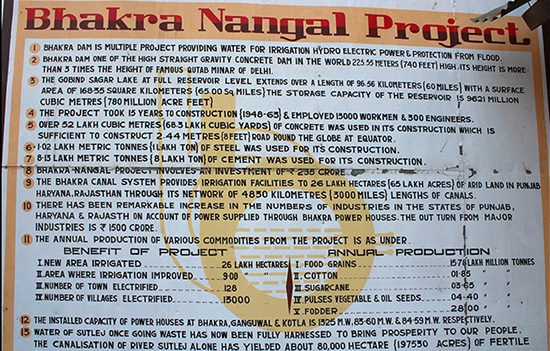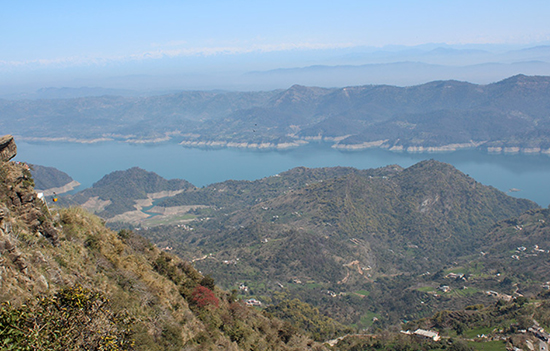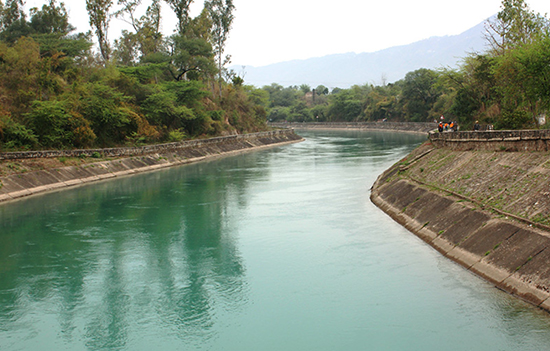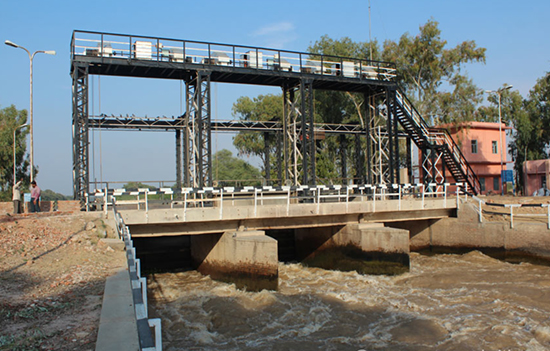- Why
was Bhakra Dam made? How does it operate? What is its importance?
- It is o/s example of inter-state co-operation. Hope its water is not used to get votes.
According
to an April 2022 report
in The Tribune, “AAP Rajya Sabha MP and state convener
Sushil Gupta claimed that AAP would form the government in 2024 in Haryana and
would provide water to each and every field of the state in 2025.” Caught on
the wrong foot in promising to provide water to Haryana through the Sutlej
Yamuna Canal, Punjab Finance Minister Cheema said on April 20 Punjab has the sole right over its waters. "Not a single drop of water would be allowed to flow out.”
Water has always been an emotive issue in
Punjab. With AAP coming to power in Punjab, seeking to win Himachal and making
promises of water supply to come to power in Haryana, it is time to jog our
memory about Bhakra Nangal (being the source of water), its importance and implications.
Why was Bhakra Dam made? How is it managed?
The
idea of tapping the waters of river Sutlej were first mooted around 1908. For
certain reasons it did not progress. The project was signed by then Punjab
Revenue Minister with the king of Bilaspur and was finalised in early 1945. Since
about 80% of irrigated area went to Pakistan it left India with meagre
irrigation resources. Thus, construction of Bhakra Nangal Project assumed
urgency. It was required for power, irrigation and flood control.
Bhakra
Dam (built on Sutlej River) has its genesis in the 1960 Indus Water Treaty
where waters of Ravi, Sutlej and Beas were allotted to India for exclusive use.
The project took fifteen years and was completed in 1963 at a cost of Rs 235
crore. The Nangal dam is on Sutlej river at Nangal i.e. 13 kms below the Bhakra
dam. Bhakra project was a joint venture between Punjab (undivided) and
Rajasthan. Cost was shared proportionately based on benefits expected.
 Board Bhakra Dam site. 2014.
Board Bhakra Dam site. 2014.
The
Gobind Sagar Reservoir is part of Bhakra Nangal project. It extends over a
length of 96.56 kms with a surface area of 168.35 sq kms and a storage capacity
of 9621 cubic metres.
 View of Gobind Sagar from Naina Devi Mandir, Himachal.
View of Gobind Sagar from Naina Devi Mandir, Himachal.
Initially
this project was about Sutlej. Later on its scope increased. River Beas (starts
from a kund in Rohtang, Himachal) was tapped through Beas project and Ravi
through Thein Dam. Through a network of canals water is provided, across
states, for irrigation.
Beas
Unit 1 is when water is diverted from Beas at Pandoh into river Sutlej over a
1000 feet drop. At this point is Dehar Power House. Unit 2 of the Beas Project
is the Pong Dam before it enters the plains at Talwara. Note Rajasthan gets
maximum water from Pong Dam (Kangra district of Himachal) on river Beas.
Bhakra
Dam is in Himachal and Nangal in Punjab.
The Pong Dam is located on river Beas in Kangra district of Himachal
Pradesh. The Ranjit Sagar Dam is located over river Ravi near village Thein in
the UT of Jammu and Kashmir and is the result of a 1979 agreement between
Himachal, Punjab and J&K.
 Ranjit Sagar Dam. 2014.
Ranjit Sagar Dam. 2014.
BBMB has an installed capacity of
2918.73 MW. Power is generated at a very low cost as the generating system is
operated with the ‘harnessed force of power’.
Due
to the Punjab Reorganization 1966, operation, maintenance and management of
Bhakra Nangal was handed over to the Bhakra Management Board in 1967. When Beas
River Projects were added to it in 1976 it was renamed as Bhakra Beas Management Board (BBMB). Water and power
allocated to undivided Punjab was partially shared with Haryana on a pre-determined
basis.
Since
then BBMB manages Bhakra dam, Dehar hydroelectricity project, Pong dam,
Ganguwal and Kotla power station. It generates, regulates and supplies power
generated from Bhakra Nangal and Beas Projects and regulates the supply of
water to Punjab, Haryana, Rajasthan, Delhi and Chandigarh. There are written
agreements on the shares of each state. Salaries and Operating costs are shared
between states on percentage of benefit received by each of the three
states.
BBMB
is run by a board. It has three full-time members i.e. Chairman who is
nominated by the Centre, Member Irrigation by the Punjab government and Member
Power by the Haryana government (last two per precedent). Two directors are
nominated by the Centre, one of whom is Commissioner Indus. Four additional
members, one each is nominated by Punjab, Haryana, Himachal and Rajasthan.
 Canal near Anandpur Sahib that receives water from Bhakra Nangal.
Canal near Anandpur Sahib that receives water from Bhakra Nangal.
Why are Bhakra Nangal and BBMB important to North India?
One, it regulates the supply of power and water to four states of North India and national capital of Delhi with Punjab, Haryana and Rajasthan being the biggest beneficiaries.
Two, its water irrigates lakhs of acres in Punjab and Haryana.
Three, it is responsible for flood control in the region.
If
emotions are raised people may take law into their own hands. In 1988 Major
General B.N. Kumar, then head of the Bhakra Beas Management Board, was killed for allegedly
causing flooding of Punjab.
Four, BBMB is a key supplier of electricity to the Northern Grid.
If
politics or mismanagement reduce power supply it could lead to power cuts in
North India.
 Indira Gandhi Canal near Bikaner. Gates control water flow. 2013.
Indira Gandhi Canal near Bikaner. Gates control water flow. 2013.
Five, Beas river water goes to many parts of Rajasthan for e.g. Jaisalmer, Bikaner and Sriganganagar.
Any
attempt to play politics with supply of water could cause social unrest.
Returning to the issue of one party ruling the states of Punjab, Haryana and Himachal. The Congress has done so in the past but with due respects and no offence meant, the Aam Aadmi Party is a disruptor and could raise emotions, take matters to Court if Delhi is a precedent. This author believes that seeking to change status-quo is good but it has to be done without arousing emotions.
Also read Who
should control bureaucrats in Delhi, SC refers matter to a Constitutional Bench
For
votes old issues may be raised or tell how a state was discriminated against
for e.g. finance minister Cheema said, “Speaking about the issue of SYL canal,
Cheema said the first discrimination against Punjab was done in 1955 when a
larger share of Ravi-Beas waters were allocated to non-riparian states by the
then Congress government.” Source
Another
e.g. When the Centre announced the implementation of Central Service Rules for
Chandigarh UT employees (not getting into right or wrong), the state government
raised the unrelated issue of transfer of Chandigarh to Punjab raising emotions
in both Punjab and Haryana.
Once emotions are aroused, protests will be organised like what we saw in Delhi in 2021. Recall the 1988 killing of Maj Gen Kumar to know what can happen when things go out of control.
Also,
terms of decade old agreements between states, that have stood the test of
time, could be re-opened by complaining of discrimination. Matter would
eventually land up in the Supreme Court! Since emotions are raised the affected
government might not implement a Supreme Court order just like its earlier
order on the Sutlej-Yamuna canal remains on paper.
We
must realize that the region is seeing peace after a long spell of terrorism in
the 1980-1990s. Raising emotive issues can create conflict which might spin out
of control. Greed for power was one of the reasons for the violence of the
1980’s.
On
management of the BBM, if 5 out of 9 members of its board are nominated by a
party i.e. politically opposed to the Centre, it could adversely affect working
of BBMB and allocation of power/water to states. A differing view is that the
Chairman’s (appointed by the Centre) decision is final.
We
must be aware that the Khalistan
map released by a U.S. based organization includes Himachal and
Haryana. They want control over water and power.
If
a party perceived as sympathetic to Khalistan assumes power in three states its
consequences might be a cause for worry. Note that Harpeet Singh Bedi, formerly
associated with AAP, favoured the demand for Khalistan according to this India Today report.
Subsequently, his twitter account was deleted.
Also read Khalistan
flags hoisted by Himachal Assembly gate in Dharamshala
It can be argued that Haryana was a part of Punjab. Using the same
logic North West Frontier Province was part of Punjab till 1901. Also since
1957, Akalis started to demand a state where Punjabi, in Gurumukhi script,
would be the state language (linguistic states was the norm then).
The purpose of flagging this issue today is for all to be aware of the possible problems that lie ahead if the working of Bhakra Dam is tampered with for votes. Leave this o/s example of inter-state cooperation alone.
All pictures by author.
References
1. Why
rule change in BBMB has become a flashpoint between Centre and Punjab
2. BBMB site
3. Education
Today
4. Saral Study on
Bhakra Nangal
5. Central Water
Commission